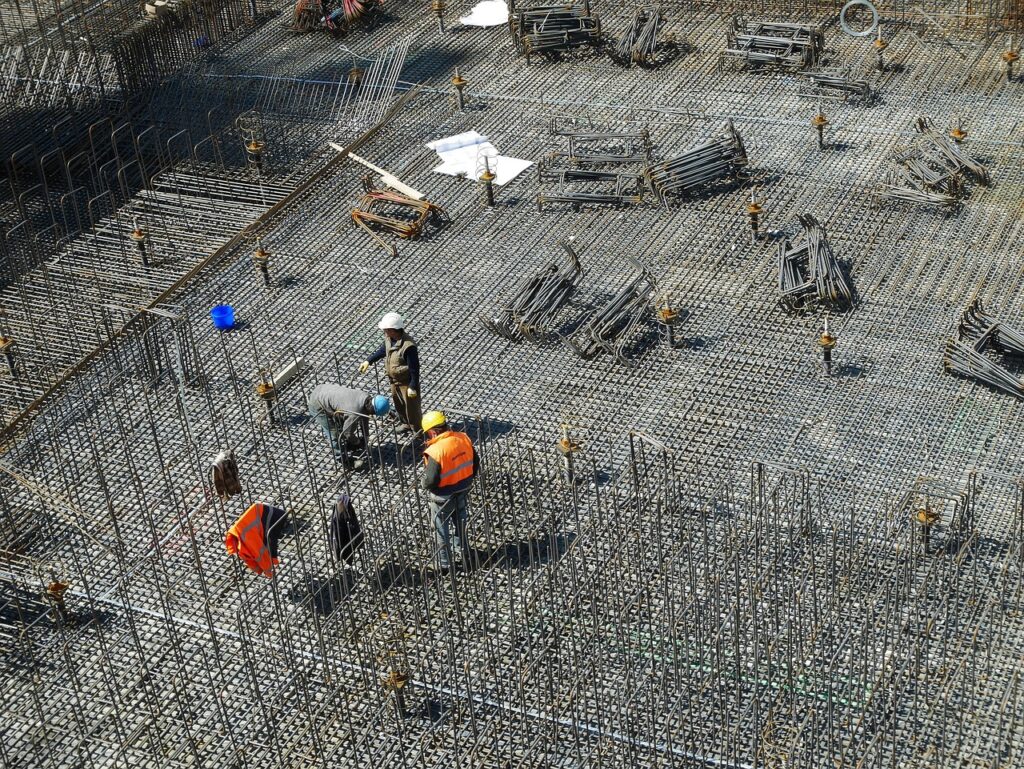If you are looking for the type of foundation to start building your metal building with, this article might help.
There are different types of foundations, including, pier, perimeter wall, and crawlspace foundations. In this blog, the folks at Lion Buildings will talk about wall foundations.
A perimeter wall foundation is a type of structural support system that outlines the outer edge of a building. It forms a continuous wall at ground level, typically made from reinforced concrete. This type of foundation is commonly used in metal building construction because it provides a stable and secure base that can carry significant structural loads.
In metal building projects, the perimeter wall serves not only as a physical boundary but also as a crucial part of the load-bearing system. It helps distribute the building’s weight evenly along its footprint. This system allows for proper anchoring of the steel framing components, offering both strength and resistance against lateral and vertical forces.
Why Metal Buildings Need a Strong Foundation
Metal buildings, although lighter than traditional structures, still require a solid and stable base to perform optimally. The foundation supports not only the weight of the steel frame but also resists environmental forces like wind, rain, and seismic activity. Without a robust foundation, the structural integrity of the building may be compromised over time.
In addition to physical support, the foundation acts as a barrier against moisture and pests. It helps prevent issues such as rust, corrosion, and degradation of the metal elements. A poorly designed foundation can lead to costly repairs and even shorten the life of the entire structure.
Components of a Perimeter Wall Foundation
The primary component of a perimeter wall foundation is the continuous concrete wall that runs along the outline of the building. This wall is typically reinforced with steel bars to increase its tensile strength and ensure long term durability. In some designs, the wall may be paired with a concrete footing below to help distribute loads more evenly.
In addition to the wall and footing, anchor bolts and plates are installed to connect the steel structure to the foundation. These components play a vital role in ensuring that the metal frame is securely attached to the concrete base. Proper alignment and installation of these connectors are crucial for structural safety.
Construction Process of a Perimeter Wall Foundation
The construction of a perimeter wall foundation begins with site excavation and grading. The soil must be leveled and compacted to ensure stability. After marking the foundation layout, trenches are dug to form the base for the concrete wall. The dimensions of these trenches depend on the building’s design and load requirements.
Once the trenches are ready, formwork and reinforcement bars are placed. Concrete is then poured and allowed to cure properly to achieve maximum strength. After curing, anchor bolts are embedded in the top surface. This allows for the secure attachment of the metal framing components during the next phase of construction.
How Perimeter Wall Foundations Support Structural Load
Perimeter wall foundations distribute the building’s weight across the entire base rather than concentrating it in a few isolated points. This method reduces stress on any single area and provides a balanced load path from the metal structure to the soil below. It also helps resist uplift and lateral movement caused by environmental forces.
The continuous nature of the perimeter wall allows it to act as a unified structural element. This ensures that vertical loads from walls and roofs, as well as horizontal loads from wind or seismic activity, are managed effectively. The result is a stable and reliable base that extends the life and performance of the metal building.
Advantages Over Other Foundation Types
Compared to pier foundations or slab on grade systems, perimeter wall foundations offer greater strength and versatility. They are particularly beneficial for buildings located in areas with uneven soil conditions or where frost lines must be considered. Their design allows for better load distribution and improved resistance to environmental pressures.
Another key advantage is the ability to create a crawlspace or basement beneath the building. This additional space can be used for utilities, storage, or mechanical systems. The raised profile also improves ventilation and can help protect the building against water damage during heavy rains or flooding.
Common Materials Used in Perimeter Wall Foundations
Concrete is the most commonly used material in perimeter wall foundations due to its strength, availability, and durability. Reinforced concrete combines the compressive strength of concrete with the tensile strength of steel rebar, creating a composite material capable of withstanding various forces.
In some cases, additional waterproofing or protective coatings may be applied to the concrete surface to enhance longevity. These treatments help prevent water penetration and resist chemical reactions that could weaken the structure over time. The quality of the materials used significantly impacts the foundation’s lifespan and effectiveness.
Soil Conditions and Site Preparation
Before construction begins, a thorough analysis of the soil is essential. Soil type, composition, and moisture content all influence how the foundation should be designed. Some soils expand and contract with changes in moisture levels, which can lead to shifting or cracking if not properly managed.
Site preparation involves grading the land to promote proper drainage and compacting the soil to reduce the risk of settling. In some cases, soil stabilization techniques may be required to enhance bearing capacity. Ensuring a solid and level base is critical for the long term performance of the foundation and the metal building it supports.
Insulation and Moisture Control in Foundation Walls
Perimeter wall foundations can be insulated to improve the energy efficiency of the building. Insulation reduces heat loss through the ground and can also help regulate indoor temperatures. This is especially important in buildings used for storage or habitation where temperature control is a priority.
Moisture control is another important consideration. Water infiltration can lead to mold growth, corrosion of metal components, and weakening of the concrete itself. Proper drainage systems, vapor barriers, and sealants are used to keep the foundation dry and protect the integrity of the building from moisture related issues.
Durability and Long Term Maintenance
A well built perimeter wall foundation can last for decades with minimal maintenance. Routine inspections help identify issues early, such as cracks, water damage, or movement. Addressing these concerns promptly can prevent larger problems and preserve the structural stability of the building.
Over time, minor repairs may be needed to maintain the foundation’s integrity. This could include patching cracks, resealing joints, or replacing deteriorated materials. Consistent maintenance not only extends the lifespan of the foundation but also safeguards the investment in the metal building itself.
Cost Considerations for Perimeter Wall Foundations
While perimeter wall foundations may have a higher upfront cost compared to simpler options, their long term benefits often outweigh the initial expense. The improved load distribution, structural stability, and potential for additional features like crawlspaces add significant value to the building project.
Factors affecting cost include the size of the building, soil conditions, depth of the foundation, and materials used. Investing in quality construction from the beginning can reduce the need for future repairs and enhance the overall performance of the building. It is often more cost effective in the long run to build it right the first time.
Integration with Building Utilities
Perimeter wall foundations allow for easier integration of utilities such as plumbing, electrical, and HVAC systems. Conduits and piping can be routed through the walls or crawlspace, keeping them protected and accessible for maintenance. This makes future upgrades or repairs more manageable.
Having a dedicated area for utilities reduces clutter within the main structure and improves overall organization. This integration is particularly useful in metal buildings used as workshops, garages, or residential spaces. Efficient utility planning enhances both function and comfort for the end user.
Regulatory Standards and Permits
Construction of perimeter wall foundations must comply with local building codes and regulations. These standards ensure safety, structural integrity, and proper design practices. Permits are usually required before any work can begin, and inspections are conducted throughout the process to ensure compliance.
Working with licensed professionals and understanding the permitting process can prevent costly delays or fines. Each jurisdiction may have specific requirements based on climate, soil conditions, and intended use of the building. Following established standards provides peace of mind and ensures the foundation will perform as intended.
Impact on Building Design and Layout
The type of foundation chosen can influence the overall design of the building. A perimeter wall foundation allows for a variety of architectural features, including raised floors, basements, and multiple levels. It also accommodates complex layouts and larger footprints more easily than other types.
Design flexibility is a major advantage for those looking to customize their metal buildings. The foundation supports not just the structure itself but also the creative vision of the owner. Being able to adapt the layout to specific needs improves the functionality and visual appeal of the final construction.
Case Studies and Real World Applications
Many successful projects have demonstrated the value of using perimeter wall foundations in metal buildings. Agricultural facilities, commercial warehouses, and residential barndominiums have all benefited from the strength and versatility of this foundation type. In each case, the foundation played a critical role in long term performance.
For example, a large equipment storage facility built on a perimeter wall foundation showed increased stability during high winds compared to similar structures on pier foundations. Another case involved a metal home where the foundation allowed for a full basement, providing additional living space and utility access. These real world applications highlight the adaptability and reliability of perimeter wall foundations.
Conclusion
A perimeter wall foundation provides a durable, versatile, and supportive base for metal buildings of all kinds. From small garages to expansive commercial facilities, this foundation type offers structural strength, design flexibility, and long term value. Understanding its components, construction process, and advantages is essential for making informed decisions in any building project.
Choosing the right foundation is one of the most important steps in creating a safe and lasting structure. With proper planning, materials, and execution, a perimeter wall foundation can enhance the performance and longevity of a metal building. This investment in quality pays dividends through reduced maintenance costs, improved utility integration, and greater adaptability for future needs.

